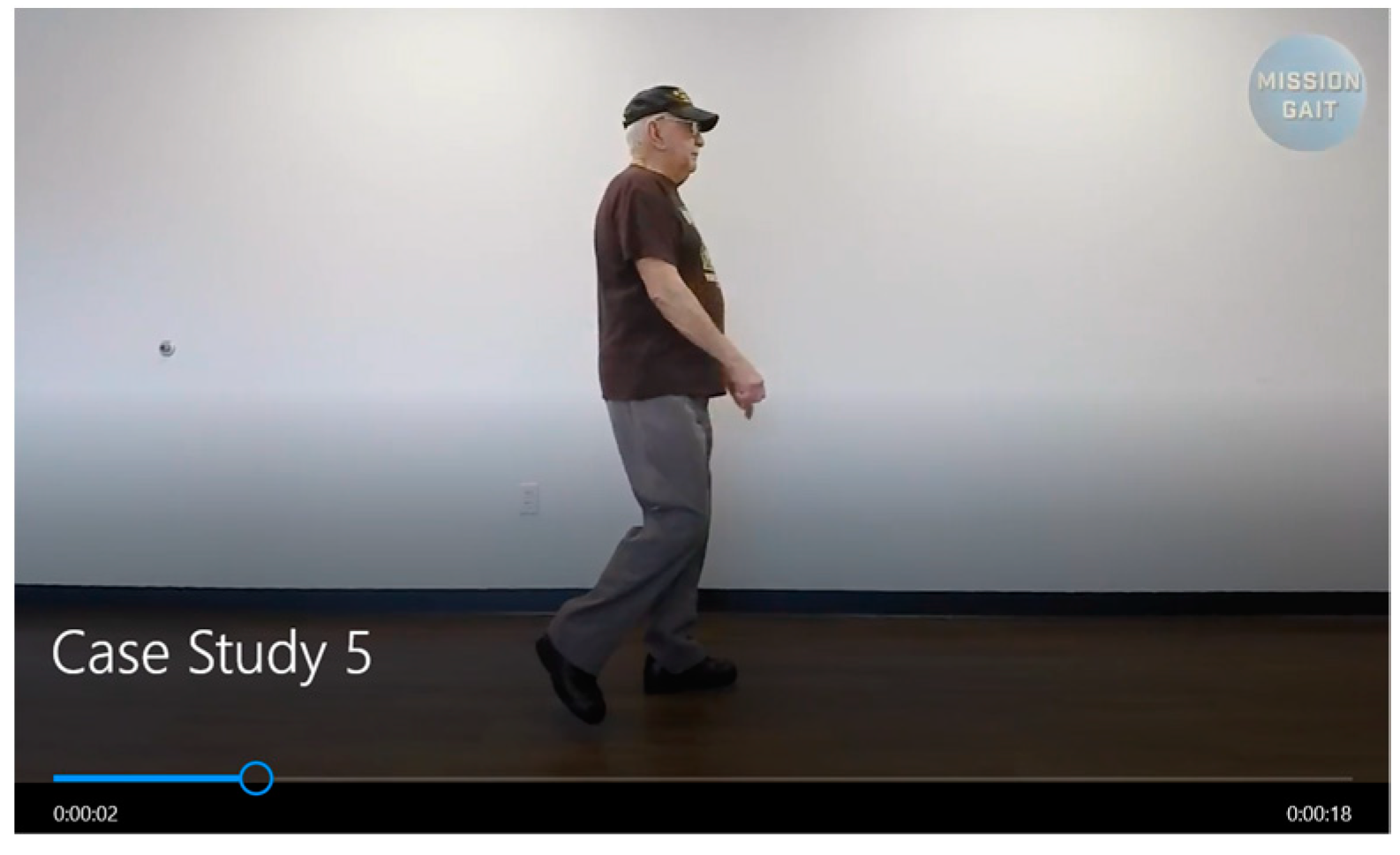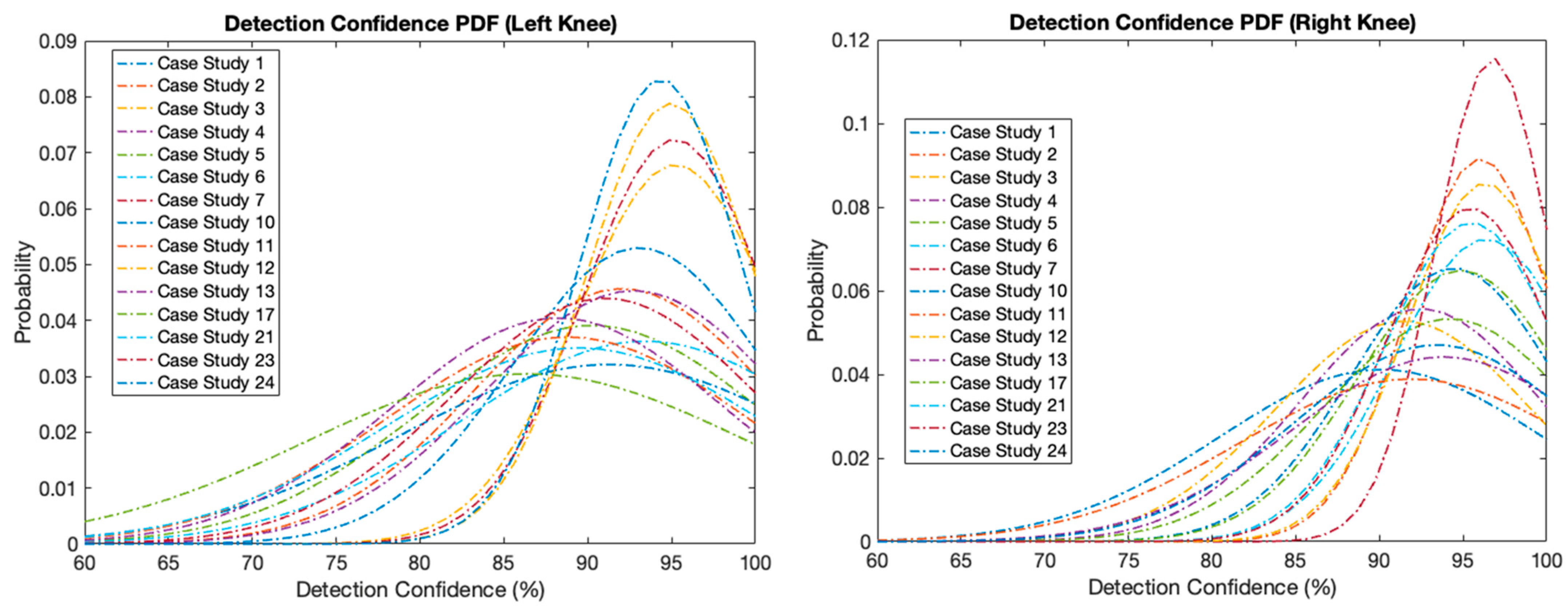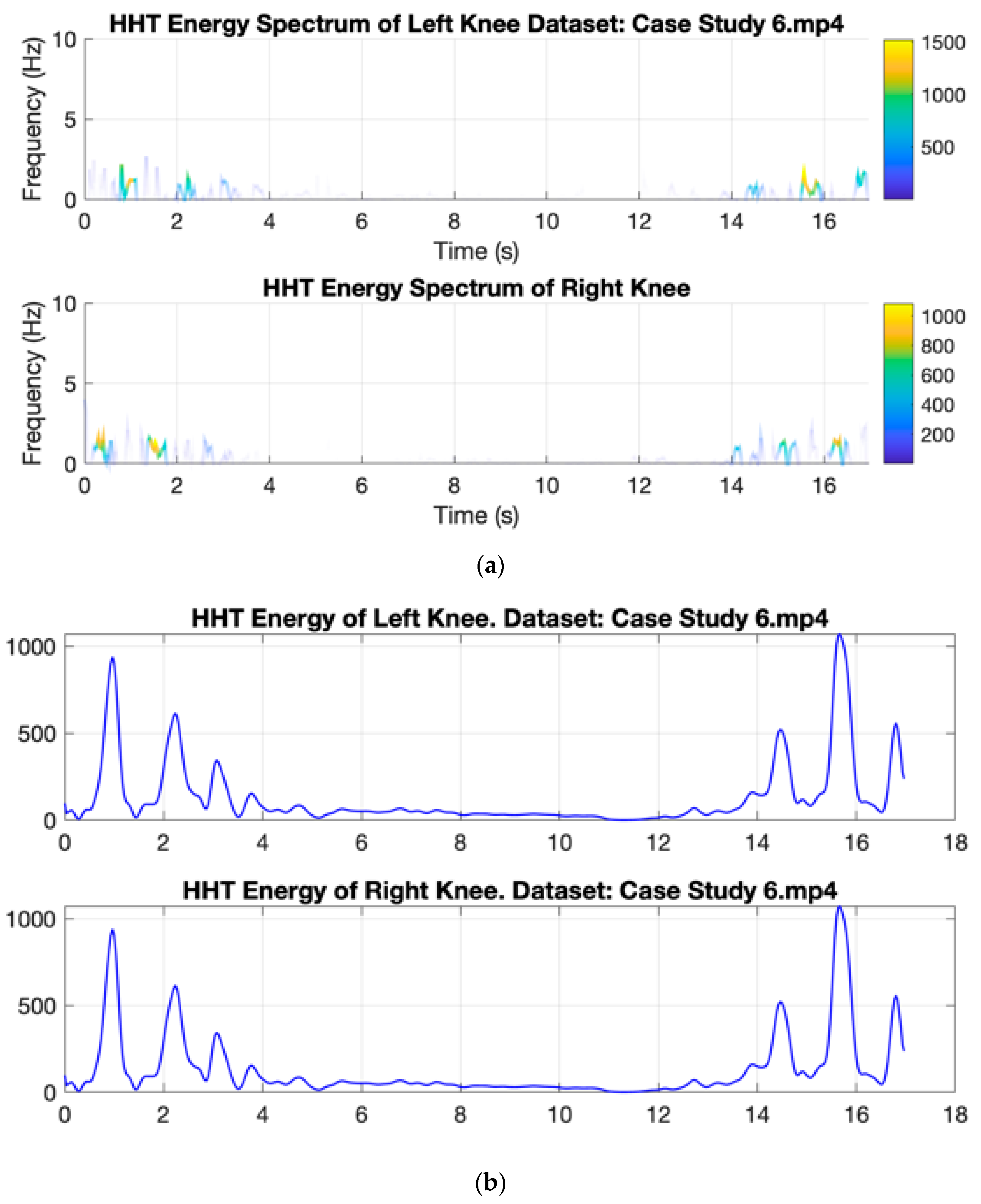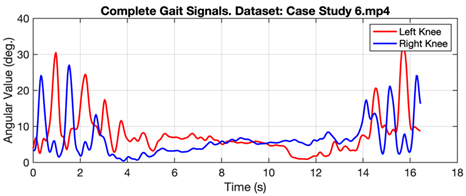Empirical Mode Decomposition and Hilbert Spectrum for Abnormality Detection in Normal and Abnormal Walking Transitions
Abstract
1. Introduction
2. Related Works
- Wearable sensors can overcome static environmental conditions due to static camera placement.
- With many sensors used, the accuracy obtained will be higher.
- Each sensor is intended to obtain specific signals from certain people.
- Wearable sensors better protect user privacy compared with cameras that can record the user’s face and body.
- There needs to be a supervisor to observe the video recording.
- Video signal processing requires more computational challenges.
3. Materials and Methods
3.1. Dataset
3.2. Empirical Mode Decomposition (EMD)
3.3. Hilbert Spectrum
4. Results and Discussion
4.1. Detection Confidence
4.2. Gait Signal Based on Video Dataset
4.3. Feature Extraction Using Hilbert Huang Transform
4.4. Classification Result
5. Conclusions
Author Contributions
Funding
Institutional Review Board Statement
Informed Consent Statement
Data Availability Statement
Conflicts of Interest
References
- Minh Dang, L.; Min, K.; Wang, H.; Jalil Piran, M.; Hee Lee, C.; Moon, H. Sensor-Based and Vision-Based Human Activity Recognition: A Comprehensive Survey. Pattern Recognit. 2020, 108, 107561. [Google Scholar] [CrossRef]
- Ahad, M.A.R.; das Antar, A.; Ahmed, M. Sensor-Based Human Activity Recognition: Challenges Ahead; Springer: Berlin/Heidelberg, Germany, 2021; pp. 175–189. [Google Scholar]
- Song, L.; Yu, G.; Yuan, J.; Liu, Z. Human Pose Estimation and Its Application to Action Recognition: A Survey. J. Vis. Commun. Image Represent 2021, 76, 103055. [Google Scholar] [CrossRef]
- Ye, Z.; Li, Y.; Zhao, Q.; Liu, X. A Falling Detection System with Wireless Sensor for the Elderly People Based on Ergonomics. Int. J. Smart Home 2014, 8, 187–196. [Google Scholar] [CrossRef]
- Lun, R.Z. Human Activity Tracking and Recognition Using Kinect Sensor. Ph.D. Thesis, Cleveland State University, Cleveland, OH, USA, 2018. [Google Scholar]
- Reyes-Ortiz, J.-L.; Oneto, L.; Samà, A.; Parra, X.; Anguita, D. Transition-Aware Human Activity Recognition Using Smartphones. Neurocomputing 2016, 171, 754–767. [Google Scholar] [CrossRef]
- Kwon, Y.; Kang, K.; Bae, C. Unsupervised Learning for Human Activity Recognition Using Smartphone Sensors. Expert Syst. Appl. 2014, 41, 6067–6074. [Google Scholar] [CrossRef]
- Munea, T.L.; Jembre, Y.Z.; Weldegebriel, H.T.; Chen, L.; Huang, C.; Yang, C. The Progress of Human Pose Estimation: A Survey and Taxonomy of Models Applied in 2D Human Pose Estimation. IEEE Access 2020, 8, 133330–133348. [Google Scholar] [CrossRef]
- Kendall, A.; Grimes, M.; Cipolla, R. PoseNet: A Convolutional Network for Real-Time 6-DOF Camera Relocalization. In Proceedings of the 2015 IEEE International Conference on Computer Vision (ICCV), Santiago, Chile, 7–13 December 2015; Volume 2015, pp. 2938–2946. [Google Scholar]
- Divya, R.; Peter, J.D. Smart Healthcare System-a Brain-like Computing Approach for Analyzing the Performance of Detectron2 and PoseNet Models for Anomalous Action Detection in Aged People with Movement Impairments. Complex Intell. Syst. 2022, 8, 3021–3040. [Google Scholar] [CrossRef]
- Serpush, F.; Menhaj, M.B.; Masoumi, B.; Karasfi, B. Wearable Sensor-Based Human Activity Recognition in the Smart Healthcare System. Comput. Intell. Neurosci. 2022, 2022, 1391906. [Google Scholar] [CrossRef]
- Bhattacharya, D.; Sharma, D.; Kim, W.; Ijaz, M.F.; Singh, P.K. Ensem-HAR: An Ensemble Deep Learning Model for Smartphone Sensor-Based Human Activity Recognition for Measurement of Elderly Health Monitoring. Biosensors 2022, 12, 393. [Google Scholar] [CrossRef]
- Ren, L.; Peng, Y. Research of Fall Detection and Fall Prevention Technologies: A Systematic Review. IEEE Access 2019, 7, 77702–77722. [Google Scholar] [CrossRef]
- Erfianto, B.; Rizal, A. IMU-Based Respiratory Signal Processing Using Cascade Complementary Filter Method. J. Sens. 2022, 2022, 7987159. [Google Scholar] [CrossRef]
- Retno, N.; Jiang, B.C. Window Selection Impact in Human Activity Recognition Window Selection Impact in Human Activity Recognition. Int. J. Innov. Technol. Interdiscip. Sci. 2020, 3, 381–394. [Google Scholar] [CrossRef]
- Amroun, H.; Ouarti, N.; Temkit, M.; Ammi, M. Impact of the Positions Transition of a Smartphone on Human Activity Recognition. In Proceedings of the 2017 IEEE International Conference on Internet of Things, IEEE Green Computing and Communications, IEEE Cyber, Physical and Social Computing, IEEE Smart Data, iThings-GreenCom-CPSCom-SmartData, Exeter, UK, 21–23 June 2017; Institute of Electrical and Electronics Engineers Inc.: Piscatevi, NJ, USA, 2018; Volume 2018, pp. 937–942. [Google Scholar]
- Saha, J.; Chowdhury, C.; Ghosh, D.; Bandyopadhyay, S. A Detailed Human Activity Transition Recognition Framework for Grossly Labeled Data from Smartphone Accelerometer. Multimed. Tools Appl. 2021, 80, 9895–9916. [Google Scholar] [CrossRef]
- Zhang, S.; Wei, Z.; Nie, J.; Huang, L.; Wang, S.; Li, Z. A Review on Human Activity Recognition Using Vision-Based Method. J. Healthc. Eng. 2017, 2017, 3090343. [Google Scholar] [CrossRef]
- Fu, B.; Damer, N.; Kirchbuchner, F.; Kuijper, A. Sensing Technology for Human Activity Recognition: A Comprehensive Survey. IEEE Access 2020, 8, 83791–83820. [Google Scholar] [CrossRef]
- Febriana, N.; Rizal, A.; Susanto, E. Sleep Monitoring System Based on Body Posture Movement Using Microsoft Kinect Sensor. In Proceedings of the 3rd Biomedical Engineering’s Recent Progress in Biomaterials, Drugs Development, and Medical Devices, Jakarta, Indonesia, 6–8 August 2018; p. 020012. [Google Scholar]
- Chua, J.; Ong, L.-Y.; Leow, M.-C. Telehealth Using PoseNet-Based System for In-Home Rehabilitation. Future Internet 2021, 13, 173. [Google Scholar] [CrossRef]
- Siddiq, M.I.; Rizal, A.; Erfianto, B.; Hadiyoso, S. Falling Estimation Based on PoseNet Using Camera with Difference Absolute Standard Deviation Value and Average Amplitude Change on Key-Joint. Appl. Mech. Mater. 2023, 913, 133–142. [Google Scholar]
- Guo, F.; He, Y.; Guan, L. RGB-D Camera Pose Estimation Using Deep Neural Network. In Proceedings of the 2017 IEEE Global Conference on Signal and Information Processing (GlobalSIP), Montreal, QC, Canada, 14–16 November 2017; pp. 408–412. [Google Scholar]
- Cao, Z.; Simon, T.; Wei, S.-E.; Sheikh, Y. Realtime Multi-Person 2D Pose Estimation Using Part Affinity Fields. In Proceedings of the IEEE Conference on Computer Vision and Pattern Recognition (CVPR), Honolulu, HI, USA, 21–26 July 2017. [Google Scholar]
- Huang, N.E.; Shen, Z.; Long, S.R.; Wu, M.C.; Shih, H.H.; Zheng, Q.; Yen, N.-C.; Tung, C.C.; Liu, H.H. The Empirical Mode Decomposition and the Hilbert Spectrum for Nonlinear and Non-Stationary Time Series Analysis. Proc. R. Soc. Lond. A 1998, 454, 903–995. [Google Scholar] [CrossRef]
- Shuvo, S.B.; Ali, S.N.; Swapnil, S.I.; Hasan, T.; Bhuiyan, M.I.H. A Lightweight CNN Model for Detecting Respiratory Diseases from Lung Auscultation Sounds Using EMD-CWT-Based Hybrid Scalogram. IEEE J. Biomed. Health Inform. 2021, 25, 2595–2603. [Google Scholar] [CrossRef]
- Villalobos-Castaldi, F.M.; Ruiz-Pinales, J.; Valverde, N.C.K.; Flores, M. Time-Frequency Analysis of Spontaneous Pupillary Oscillation Signals Using the Hilbert-Huang Transform. Biomed. Signal Process. Control 2016, 30, 106–116. [Google Scholar] [CrossRef]
- Caseiro, P.; Fonseca-Pinto, R.; Andrade, A. Screening of Obstructive Sleep Apnea Using Hilbert-Huang Decomposition of Oronasal Airway Pressure Recordings. Med. Eng. Phys. 2010, 32, 561–568. [Google Scholar] [CrossRef]
- Lozano, M.; Fiz, J.A.; Jané, R. Performance Evaluation of the Hilbert-Huang Transform for Respiratory Sound Analysis and Its Application to Continuous Adventitious Sound Characterization. Signal Process. 2016, 120, 99–116. [Google Scholar] [CrossRef]
- Rizal, A.; Hidayat, R.; Nugroho, H.A. Lung Sound Classification Using Empirical Mode Decomposition and the Hjorth Descriptor. Am. J. Appl. Sci. 2017, 14, 166–173. [Google Scholar] [CrossRef]
- Hernández, D.E.; Trujillo, L.; Z-Flores, E.; Villanueva, O.M.; Romo-Fewell, O. Detecting Epilepsy in EEG Signals Using Time, Frequency and Time-Frequency Domain Features. In Studies in Systems, Decision and Control; Springer: Cham, Switzerland, 2018. [Google Scholar]
- Chen, X.; Cheng, Z.; Wang, S.; Lu, G.; Xv, G.; Liu, Q.; Zhu, X. Atrial Fibrillation Detection Based on Multi-Feature Extraction and Convolutional Neural Network for Processing ECG Signals. Comput. Methods Programs Biomed. 2021, 202, 106009. [Google Scholar] [CrossRef]










| Case Study | ||||||
| 1 | 2 | 3 | 4 | 5 | 6 | 7 |
 |  |  |  |  |  |  |
| N | LLD | KA | PD2 | DN | PD 1 | N |
| Case Study | ||||||
| 10 | 11 | 12 | 13 | 17 | 21 | 23 |
 |  |  |  |  |  |  |
| N | N | MS | HP | CH | PD3 | BI |
| Dataset | Video Duration (Second) | Initial Direction | Status Gait |
|---|---|---|---|
| Case Study 1 | 13 | Right to Left | N: Normal, normal walking gait taken from author |
| Case Study 2 | 16 | Left to Right | LLD: Leg Length Discrepancy |
| Case Study 3 | 25 | Right to Left | KA: Knee Amputee is amputation from knee below |
| Case Study 4 | 13 | Left to Right | PD2: Parkinson Disease (Mild) |
| Case Study 5 | 20 | Left to Right | DN: Diabetic Neuropathy is a motor nerve disorder caused by diabetes. |
| Case Study 6 | 17 | Left to Right | PD1: Parkinson Disease (Severe) |
| Case Study 7 | 18 | Right to Left | Normal (Video from mission gait) |
| Case Study 10 | 20 | Right to Left | Normal (Video from mission gait) |
| Case Study 11 | 18 | Right to Left | Normal (Video from mission gait) |
| Case Study 12 | 20 | Right to Left | MS: Multiple Sclerosis is a movement disorder due to communication disorders between the brain and the motor system of the body |
| Case Study 13 | 21 | Left to Right | HP: Hemiplegic, motoric disorder as common long-term consequence of stroke |
| Case Study 17 | 29 | Left to Right | CH: Chronic Hemiparetic |
| Case Study 21 | 22 | Left to Right | PD3: Parkinson Disease (Moderate) |
| Case Study 23 | 11 | Left to Right | BI: Brain Injury |
| Case Study 24 | 14 | Left to Right | DS: Dystonia is movement disorder that causes the muscles to contract involuntarily |
| Gait Signals | |
|---|---|
| Case Study 10 |  |
| Case Study 6 |  |
| Case Study 5 |  |
| Dataset | Class |
|---|---|
| Case Study 1 | NW |
| Case Study 2 | OW |
| Case Study 3 | OW |
| Case Study 4 | PD |
| Case Study 5 | OW |
| Case Study 6 | PD |
| Case Study 7 | NW |
| Case Study 10 | NW |
| Case Study 11 | NW |
| Case Study 12 | OW |
| Case Study 13 | OW |
| Case Study 17 | OW |
| Case Study 21 | PD |
| Case Study 23 | OW |
| Case Study 24 | OW |
| NW | OW | PD | ||||
|---|---|---|---|---|---|---|
| TPR | FNR | TPR | FNR | TPR | FNR | |
| Case Study 1 [NW] | 0.618 | 0.382 | 0 | 0 | 0 | 0 |
| Case Study 2 [OW] | 0 | 0 | 1 | 0 | 0 | 0 |
| Case Study 3 [OW] | 0 | 0 | 0.311 | 0.688 | 0 | 0 |
| Case Study 4 [PD] | 0 | 0 | 0 | 0 | 0.14 | 0.86 |
| Case Study 5 [OW] | 0 | 0 | 0.46 | 0.54 | 0 | 0 |
| Case Study 6 [PD] | 0 | 0 | 0 | 0 | 1 | 0 |
| Case Study 7 [NW] | 0.759 | 0.241 | 0 | 0 | 0 | 0 |
| Case Study 10 [NW] | 1 | 0 | 0 | 0 | 0 | 0 |
| Case Study 11 [NW] | 0.256 | 0.744 | 0 | 0 | 0 | 0 |
| Case Study 12 [OW] | 0 | 0 | 0.328 | 0.672 | 0 | 0 |
| Case Study 13 [OW] | 0 | 0 | 0.481 | 0.519 | 0 | 0 |
| Case Study 17 [OW] | 0 | 0 | 0.344 | 0.656 | 0 | 0 |
| Case Study 21 [PD] | 0 | 0 | 0 | 0 | 0.266 | 0.733 |
| Case Study 23 [OW] | 0 | 0 | 0.452 | 0.548 | 0 | 0 |
| Case Study 24 [OW] | 0 | 0 | 0.379 | 0.621 | 0 | 0 |
Disclaimer/Publisher’s Note: The statements, opinions and data contained in all publications are solely those of the individual author(s) and contributor(s) and not of MDPI and/or the editor(s). MDPI and/or the editor(s) disclaim responsibility for any injury to people or property resulting from any ideas, methods, instructions or products referred to in the content. |
© 2023 by the authors. Licensee MDPI, Basel, Switzerland. This article is an open access article distributed under the terms and conditions of the Creative Commons Attribution (CC BY) license (https://creativecommons.org/licenses/by/4.0/).
Share and Cite
Erfianto, B.; Rizal, A.; Hadiyoso, S. Empirical Mode Decomposition and Hilbert Spectrum for Abnormality Detection in Normal and Abnormal Walking Transitions. Int. J. Environ. Res. Public Health 2023, 20, 3879. https://doi.org/10.3390/ijerph20053879
Erfianto B, Rizal A, Hadiyoso S. Empirical Mode Decomposition and Hilbert Spectrum for Abnormality Detection in Normal and Abnormal Walking Transitions. International Journal of Environmental Research and Public Health. 2023; 20(5):3879. https://doi.org/10.3390/ijerph20053879
Chicago/Turabian StyleErfianto, Bayu, Achmad Rizal, and Sugondo Hadiyoso. 2023. "Empirical Mode Decomposition and Hilbert Spectrum for Abnormality Detection in Normal and Abnormal Walking Transitions" International Journal of Environmental Research and Public Health 20, no. 5: 3879. https://doi.org/10.3390/ijerph20053879
APA StyleErfianto, B., Rizal, A., & Hadiyoso, S. (2023). Empirical Mode Decomposition and Hilbert Spectrum for Abnormality Detection in Normal and Abnormal Walking Transitions. International Journal of Environmental Research and Public Health, 20(5), 3879. https://doi.org/10.3390/ijerph20053879







